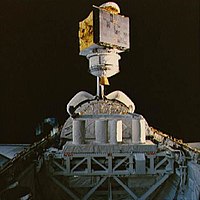
Photo from wikipedia
Low-Earth orbit (LEO) satellite networks are meant to be fundamental to closing the digital divide, enabling new market opportunities and providing fifth-generation (5G) New Radio (NR) connectivity everywhere at any… Click to show full abstract
Low-Earth orbit (LEO) satellite networks are meant to be fundamental to closing the digital divide, enabling new market opportunities and providing fifth-generation (5G) New Radio (NR) connectivity everywhere at any time. Despite the advantages of LEO deployments, these systems are characterized by a high mobility and a challenging propagation channel that compromise several procedures of the current 5G standards. One of the impacted areas is the radio mobility management, which is used to ensure continuous and satisfactory service while users handover among cells. Current research shows that the measurement-based 5G NR handover (HO) procedures, designed for terrestrial networks, fail to ensure optimal mobility performance. In this work, we provide a mobility performance analysis through extensive system-level simulations of state-of-the-art HO procedures for 5G NR over LEO satellite networks with Earth-moving cells. Furthermore, this article presents a novel antenna gain-based HO solution for intra-satellite mobility that exploits the predictability of the satellites movement and the antenna gain of the satellite beams, making user equipment (UE)’s radio measurements obsolete. The system-level simulation results, which consider users in rural and urban scenarios, show that by exploiting the known satellite’s trajectory, the UE eliminates service failures and undesired HO events, maximises the time-of-stay in a cell and experiences improved downlink signal-to-interference-plus-noise ratio. This article also includes a sensitivity study of the impact on the mobility performance of satellite-specific and UE-specific errors such as the UE’s location error, the satellite beam’s antenna radiation error and the satellite’s pointing error. Finally, the impact of the UE’s mobility is analyzed.
Journal Title: IEEE Access
Year Published: 2022
Link to full text (if available)
Share on Social Media: Sign Up to like & get
recommendations!